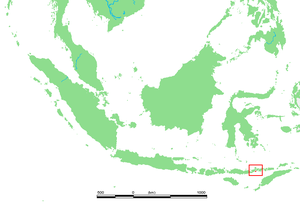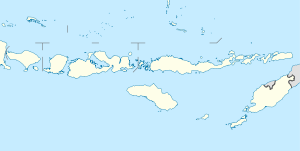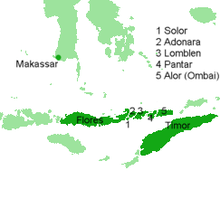Solor
| Solor | ||
|---|---|---|
| Location of Solor | ||
| Waters | Sawu Lake | |
| Archipelago | Lesser Sunda Islands | |
| Geographical location | 8 ° 37 ′ S , 122 ° 13 ′ E | |
|
|
||
| length | 40 km | |
| width | 6 km | |
The island of Solor belongs to the Indonesian Solor Archipelago and thus to the Lesser Sunda Islands .
geography
Solor is 40 km long and 6 km wide. Their area is 222 km². To the north is the island of Adonara and to the east Lembata (Lomblen), which also belong to the Solor Archipelago. To the west is Flores . South of Solor, the covers Savu Sea . Solor belongs to the province of East Nusa Tenggara . There are at least five volcanoes on the island .
Cities and villages
- Aplame
- Balawelin
- Kelike
- Kukuwerang
- Lamakera
- Lamawolo
- Levograran
- Liko
Residents
27,058 people live on Solor (2010). They traditionally speak Adonara and Lamaholot ( Solorese ). The population has lived from whaling for centuries .
history
In 1520, the Portuguese established a trading post in the town of Lamakera on the eastern side of the island as a stopover on the way from the Moluccas to Malacca . In 1530 the number of Portuguese and native Christians was already a total of 25,000. In 1562 the Dominicans built a fort made of palm trunks to protect against attacks by local pirates, which was burned down by Javanese Muslims a year later. The fortress was rebuilt from stones and armed with 50 cannons in 1566 when the Dominicans began to Christianize the local population. In the first years some soldiers were hired under a captain for Solor. From 1575 an armed ship with 20 soldiers was stationed here and from 1595 Goa officially assigned the post of Capitão, who took over the duties of governor for the region, much to the displeasure of the Dominicans, who saw their rights restricted. The first Capitão Goa was Antonio Viegas . In 1599 five churches had already been built on Solor.
In the 16th century, the trade routes were heavily dependent on the season. The caravels left Goa in September with the monsoons blowing southwards . From Malacca Indian goods were then exchanged for Chinese copper coins in Java. In exchange, further east on Sumbawa, rice and simple cotton fabrics were obtained, which in turn were exchanged for spices on the Banda Islands and Ternate . Some of these commercial travelers also came to Solor and Timor to purchase sandalwood. Between May and September, the south-west monsoons returned to Malacca. By 1582 the value of goods brought from Solor to Malacca was between 3,000 and 4,000 cruzados annually.
There was always resistance against the Portuguese and their religion. From 1598 to 1599, the Portuguese needed an armada of 90 ships to put down a local revolt against Capitão Antonio de Andria. The Laboiana Fort ( Levahojong, Lavang ) was burned down by the insurgents. It was rebuilt soon afterwards. Due to conflicts with the missionaries, the merchants left Solor in 1599 and settled in Larantuka on Flores. In 1602 the Buginese attacked the fortress with 37 ships and 3,000 men. The siege ended when Portuguese reinforcements arrived.
In January 1613 the Dutch under Apollonius Schotte bombed the fortress and landed. The Portuguese commander Alvarez surrendered on April 20, and several thousand Portuguese, mestizo and locals left Solor for Larantuka. Likewise the seven Dominican priests. Schotte reports that at that time there were three villages with "new Christians", five Muslim and many more villages on Solor. The Dutch occupied the fortress and renamed it Fort Henricus . The new commandant Adriaan van der Velde destroyed the Catholic Church. The Dutch couldn't make a profit with this branch. After two commanders defected to the Portuguese they gave up Solor in 1615, but occupied it again in 1618 under Captain Crijin van Raenburch . In 1621 an attempt at reconquest by the Portuguese failed. The Dutch were helped in defense by the Muslims. The mood in the Dutch camp sank noticeably, which was evident in numerous desertions, including from the Dutch commander Jan Thomaszoon in 1624. His successor from 1627, the mestizo Jan da Hornay (also d'Hornay or João de Horney) arrived in February 1629 the Portuguese over to Larantuka. His family was to become one of the dominant clans there. The Dutch East India Company then gave up the fortress again. The Dominicans occupied Solor again in April 1630. Francisco Fernandes became Portuguese commander . The destroyed fortress was rebuilt and armed with 15 cannons. A Dutch attack under Captain Tombergen was successfully repulsed on June 18, 1636, but the fortress was abandoned by the Dominicans in the same year. In 1640 the Macassars plunder the small Portuguese trading post and burn it down. In 1642 an official from Goa reported to the Portuguese King João IV. Copper had been found on Solor and requested that a ship be sent to occupy the island, but the request remained unanswered. It was not until February 1646 that the Dutch occupied the fortress again. The new commandant was suspended after marrying a local woman. The next commander challenged the Portuguese commander to a duel and was slain. In 1648 the Dutch left the island and the Dominicans returned. In 1653 there was an earthquake on Solor.
In 1851 the Portuguese governor José Joaquim Lopes de Lima sold Solor and other areas of the Lesser Sunda Islands, which were under Portuguese sovereignty, to the Netherlands for 200,000 florins without authorization from Lisbon. Lisbon did not recognize the sale and had Lopes arrested. He died on the way back to Europe. From 1854 the agreements were renegotiated. The sale was finally confirmed in the Lisbon Treaty . The ratification took place in 1859. Although the Dutch occupied the fort with a small force, the occupation was withdrawn again in 1869 for economic reasons. The official affiliation to the Netherlands remained.
Sons and daughters of the island
- Francisco Fernandes , 17th century military commander, Topasse
literature
- Robert H. Barnes: Lamakera, Solor. Ethnographic Notes on a Muslim Whaling Village of Eastern Indonesia . In: Anthropos. Internationale Zeitschrift für Völker- und Sprachenkunde , Vol. 91 (1996), pp. 75–88.
Web links
- Portuguese and Dutch in Timor and Solor (English)
- Remains of the Portuguese fortress on Solor (English)
Individual evidence
- ↑ a b c d e History of Timor ( Memento of the original from March 24, 2009 in the Internet Archive ) Info: The archive link was inserted automatically and has not yet been checked. Please check the original and archive link according to the instructions and then remove this notice. (PDF; 824 kB) - Technical University of Lisbon
- ^ MC Ricklefs: A History of Modern Indonesia Since c.1300 . 2nd Edition. MacMillan, London 1991, ISBN 0-333-57689-6 , pp. 25 .
- ↑ Monika Schlicher: Portugal in East Timor. A critical examination of the Portuguese colonial history in East Timor from 1850 to 1912 . Abera, Hamburg 1996, ISBN 3-931567-08-7 , ( Abera Network Asia-Pacific 4), (also: Heidelberg, Univ., Diss., 1994).
- ↑ Chronologie de l'histoire du Timor (1512-1945) suivie des événements récents (1975-1999) (French; PDF; 887 kB)
- ↑ Ronald Daus: The Invention of Colonialism . Hammer, Wuppertal 1983, ISBN 3-87294-202-6 , p. 325-327 .



